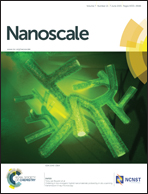Formation of Pt decorated Ni–Pt nanocubes through low temperature atomic diffusion – time-resolved elemental analysis of nanoparticle formation
Abstract
The formation process of Pt decorated Ni–Pt nanocubes was investigated by analysing the elemental distribution of Ni and Pt in the particles obtained from time-resolved in situ sampling during the synthesis in the oleylamine–1-heptanol system. The analysis confirmed the formation of Pt(core)–Ni(shell) nanoparticles at the initial stages of the reaction. However, as the reaction time progressed, the Pt atoms at the centre diffused outward and reached the corners and edges of the particle, whose shape changed from nearly spherical at the initial stages of the reaction to a perfect cube at the end of the reaction, forming a Ni rich cube (core)–Pt(cage). The cage obtained by dissolving the Ni rich cube was composed mainly of Pt and the Ni content in the frame was a mere 12%. The catalytic activity of the Pt cage was measured using cyclic voltammetry. The initial measurements suggested that the activity was comparable to some of the commercially available Pt catalysts.


 Please wait while we load your content...
Please wait while we load your content...